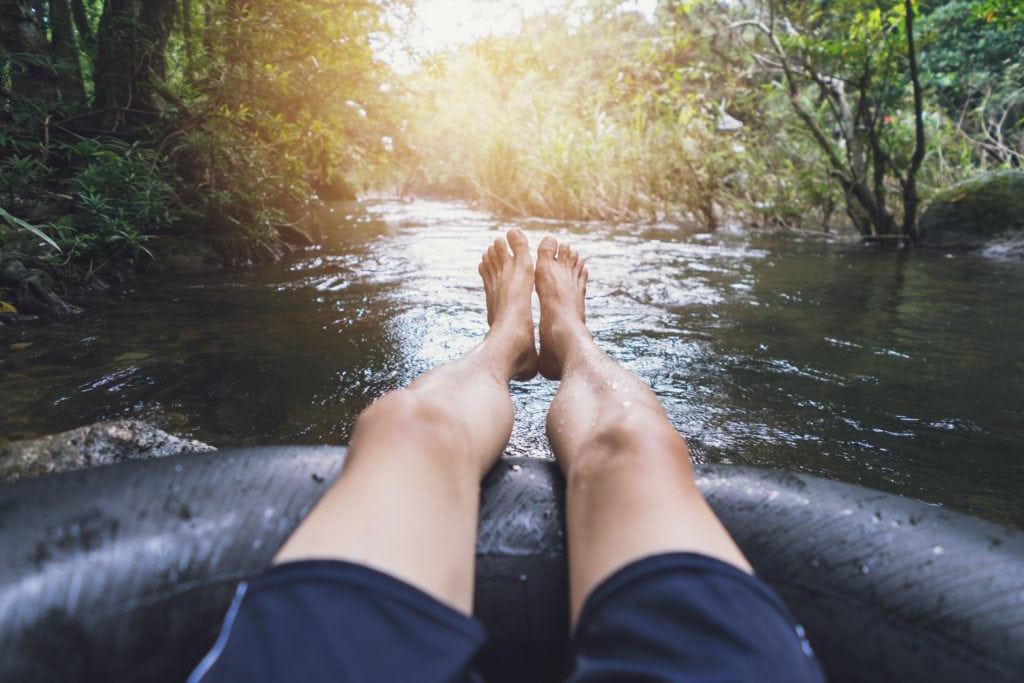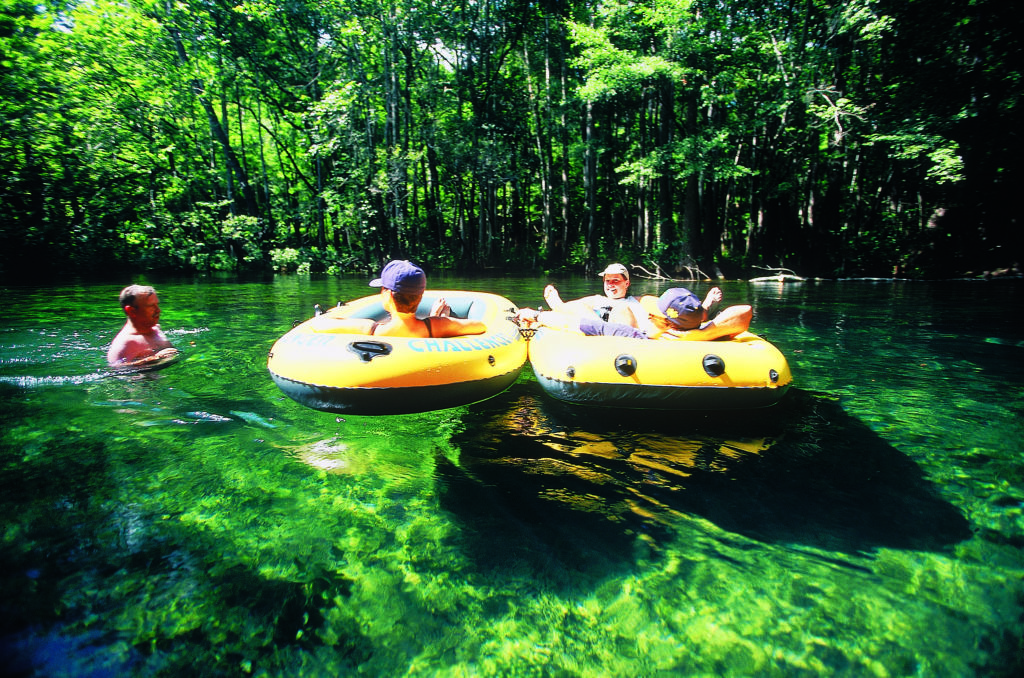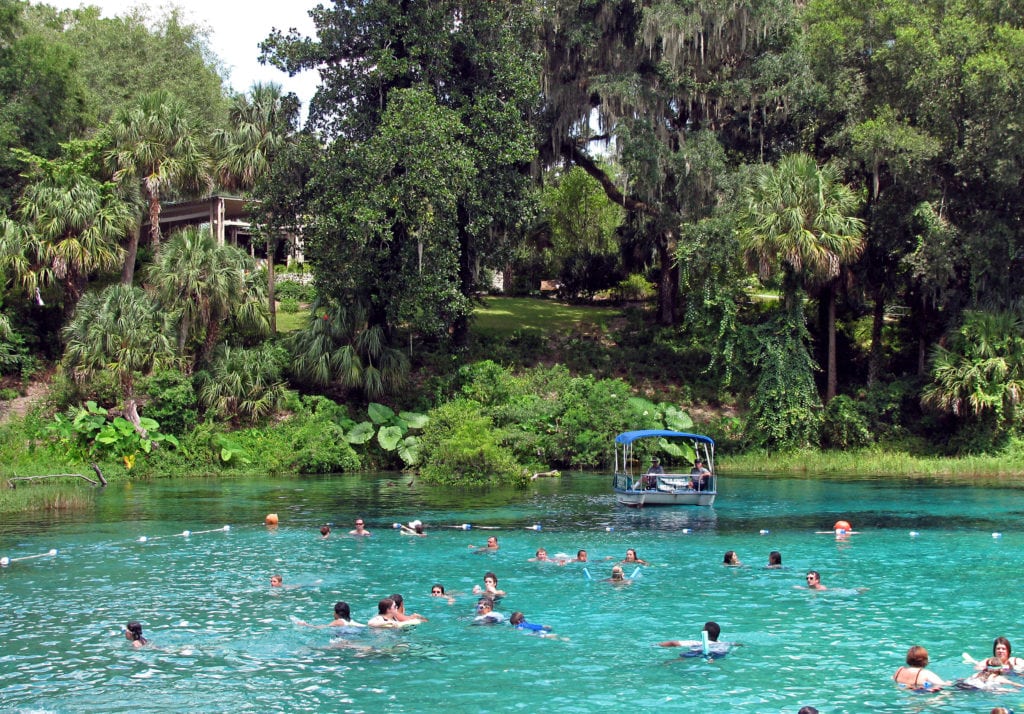Summer tubing adventures to keep you cool.

Florida has summer days so hot that even the cacti are looking for shade. What better way to beat that summer heat than floating down one of the state’s pristine meandering waterways? And what more leisurely way to float along than on a nice comfy inner tube?
Tubing has been around since great- grandpa and grandma pulled on their wool one-piece swimsuits and grabbed a couple of Model T inner tubes. But recently this leisure-time activity has skyrocketed in popularity. It is a great way to have fun while traversing Florida’s beautiful waterways without impinging on the natural habitat.
Here are a few of Florida’s finest tubing springs and rivers where you can close your eyes, lie back and float away.
Ichetucknee Springs State Park
“Ichetucknee is one of the premier tubing rivers in Florida,” says Assistant Park Manager Ray Semanchik. “The water is 72 degrees year-round, it is clear and clean, and there is plenty of wildlife to see all along the river.”

According to Semanchik, the park is open year-round, but there is a “tubing season” that takes place from the Saturday before Memorial Day (May 26) to Labor Day (September 3). Only during the tubing season can tubers enter the water at the “North Entrance,” which provides access to Ichetucknee Springs and Blue Hole Springs. There are two other places where tubers can enter the water: Midpoint and Dampier’s Landing, and these two sites can be accessed all year long.
The park opens at 8am every day, and Semanchik suggests getting there as early as possible. The North Park Entrance closes at 2pm or whenever 750 people have entered the water, whichever comes first. Midpoint closes at 4pm or whenever 2,250 people have entered the water, whichever comes first. Dampier’s Landing closes at 5pm, and there is no limit as to how many tubers can enter at this location. During the peak of the season, the day’s quota can be reached quite early in the day.
“My friends and I have tubed most of the rivers in Florida, and Ichetucknee is probably my favorite,” says Marion County resident Alisha Smith. “We go in at the North Entrance, and it usually takes us around four to five hours to finish. We stop along the way and dive off the rocks and swim and just generally have a lot of fun. There’s no better way to cool off, but be prepared—the water’s cold compared to the air, and if you aren’t careful, you can get pretty cold by the end of the trip. It may sound strange saying you can be too cold when it’s almost 100 degrees out, but it can definitely happen when you’re on any spring-fed river in Florida for a long period of time.”
Semanchik says that many of the tubers wear wet suits to protect against the cool water, but it’s not a necessity. The lower water temperature also helps when it comes to wildlife—it is too cool for alligators, and snakes are very rarely seen in the water. However, other wildlife, such as otters, beaver, fish, an abundance of water birds and the occasional manatee, make the trip downriver an experience to remember.
The river’s current is approximately one mile per hour, and it takes about three and one half hours to make the complete trip from the upper North Entrance, one and one half hours from Midpoint and 45 minutes from Dampier’s Landing. Midpoint and Dampier’s Landing can only be accessed through the South Entrance.
Ichetucknee Springs State Park is located northwest of Gainesville off State Road 238 (north entrance) and State Road 47 (south entrance). It is about an hour drive from Ocala and costs $6 per vehicle to enter the park. Tubes can be rented at the park or at nearby private rental businesses, or you can bring your own, just make sure it is less than 5 feet in diameter.
Food, alcohol, anything in disposable containers, coolers, pets and tobacco aren’t allowed on the river. There is a full-service concession stand at the South Entrance where food and drinks are available.
Detailed information can be found at floridastateparks.org/park/Ichetucknee-Springs.
Ginnie Springs
The Ichetucknee is a tributary of the Santa Fe River, and a mere 10 miles south of the Southern Entrance to Ichetucknee Springs State Park, you’ll come to Ginnie Springs nestled into the western bank of the serene Santa Fe.
The Santa Fe runs east to west, and if you enter the river at Devil’s Spring, you can tube for a little more than an hour before you come to Twin Spring. Because the river has three massive, sweeping turns, it only takes about 15 minutes to walk back on the “Tube Trail” to where you started from and do it all over again.
Ginnie Springs is a privately owned park that offers a large campground for visitors who want to spend more than one day exploring the river. This run is unique in that it allows alcoholic beverages on the water and in the campground. Keep that in mind when considering a family trip.
“If you’re young and looking for a great time, this place has a lot of loud music and everybody has some fun,” says Smith.
The park opens at 8am and closes one half hour before sunset. Day visitors pay around $15 for a day pass for adults and $4 for children 6 to 12 years old. Campers pay around $25 each per night for adults and $7 for children 6 to 12. Prices can increase on major holidays and holiday weekends.
The park is located off State Road 47 at 7300 Ginnie Springs Road in High Springs. For more information, visit ginniesprings.com.
Rainbow Springs State Park
If you want to stay a little closer to home, try Rainbow Springs State Park just northeast of Dunnellon. Tubing isn’t allowed at the headwater spring itself, but you can swim there. Alcohol, coolers and anything in disposable containers are not allowed on the river.

Tubers can enter the water in two places: a state park tubing entrance on the east side of the river at 10830 SW 180th Avenue Road or at KP Hole, a county-owned park on the west side of the river. At the state park entrance, you can park your car, rent a tube and then ride a shuttle upstream where you can enter the water. You then float back down to where your vehicle is parked. Tubers entering at KP Hole have two choices: They can be ferried upstream for a price and have a leisurely, two-hour float back down to KP Hole, or they can start their day’s journey at KP Hole and have a much longer four-hour float down to the takeout point at the County Highway 484 bridge.
“Rainbow Springs is unbelievably beautiful,” says Smith, “and the river is peaceful and relaxing. But it’s not quite as wild in the nature sense. There are a lot of houses along one side of the river, so it doesn’t seem as natural in some ways, but the water is crystal clear, and there’s still plenty of wildlife. The trip from KP to the bridge can take more than four hours, so make sure you’re up to being in the water that long.”
For more information and pricing on rentals, visit kphole.com or call (352) 489-3055 or visit floridastateparks.org/park/Rainbow-Springs or call (352) 465-8555.
More Fun!
For other great tubing experiences, check out:
- Rock Springs Run at Kelly Park in Apopka
- Blue Spring State Park in Orange City on the St. Johns River
- Madison Blue Spring State Park east of Madison
What To Take:
- Plenty of drinking water
- Sunscreen
- Water shoes
- A waterproof bag or several large Ziploc-type bags to hold your cell phone, wallet, small towels, etc.
- A waterproof first-aid kit
- Sunglasses
- A cap or hat
- Authorized flotation devices or life jackets for all children under 16 years of age
- A well-made plastic or inflatable cooler (Check each park to make sure it is allowed.)
- Bungee cords, rope and carabiners to keep you and your friends or family together
- Swimming lessons—it pays to be a strong swimmer
What Not To Take:
- Anything you can’t afford to lose
- Disposable or glass containers of food or liquids
- Styrofoam coolers
- Alcoholic beverages (Check with each park prior to your visit.)
- Pets (unless allowed)
What To Be Aware Of:
- Alligators: Unless the water is too cold for them, they can be found in pretty much every body of water in the state. (This is another reason you don’t want to bring pets.)
- Snakes: Same as alligators, they can be found pretty much anywhere there is warm water.
- Stinging insects: They are attracted to water and may have nests on low hanging branches
- Thunderstorms: Nothing can be as utterly frightening as being caught on a river during a Florida summertime thunderstorm.






